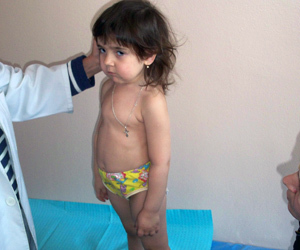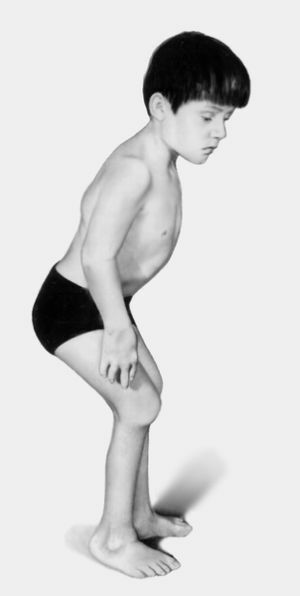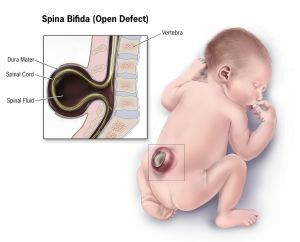 Spondyloepiphisal dysplasia is a disease in which, as a rule, serious inhibition occurs in the development of cartilaginous tissues, which should be responsible for the normal formation of the human skeleton, so all disorders affect the vertebra, pelvic bones and wrists.
Spondyloepiphisal dysplasia is a disease in which, as a rule, serious inhibition occurs in the development of cartilaginous tissues, which should be responsible for the normal formation of the human skeleton, so all disorders affect the vertebra, pelvic bones and wrists.
Most often, abnormal development affects the upper and lower extremities.
Specialists classify spondyloepiphysary dysplasia into several categories:
- anomaly in which all vertebrae are exposed to the disturbance simultaneously;
- vertebrae can change even with the slightest deformations of the epiphyses;
- those cases when the main impact falls precisely on the upper and lower limbs.
Contents of the article
- Features of the
- Development of the
- The genetic aspect of the
- The clinical picture
- Diagnosis of the disorder
- The possibilities and methods of therapy
- Prognosis and life expectancy
- About the prevention of the disease
Features of the development of
The insidiousness of the disease consists in the fact that it can not always be recognized at the earliest stages. For example, a newborn baby,  can be completely healthy at first glance, and the disease develops, it only begins to half a year.
can be completely healthy at first glance, and the disease develops, it only begins to half a year.
If the disease is of the most serious nature, during the first year of the development of the child, only a small amount of hips can be seen.
Further, when the child begins to lead an active lifestyle, other signs are added, which can not be ignored: the child begins to walk, swinging from one leg to the other, otherwise it is considered a "duck walk", quickly gets tired and not very oftenruns, problems with hip joints begin, and then with knees.
Recognizing the disease completely is sometimes obtained by the age of seven, when lumbar lordosis begins to manifest itself.
Changes in the skeleton become apparent, and most often these changes are observed in the legs.
Child development at this stage does not stop, it continues to grow, and the physique itself remains practically proportional.
Direct changes also occur in the internal organs, often in children there is a violation in the muscle tone, with the appearance of a transverse hernia, the liver and spleen increases.
Genetic side of the
issue It should be clearly understood that spondyloepiphysic limb dysplasia can be acquired during life, but only at an early age, when the child has an incorrect load distribution throughout the skeleton, but more often this disease arises at the genetic level and is transmittedfrom parents to the child by inheritance.
In the second case, the pathology is noticed much earlier and even there is a chance of recovery.
X-rays can be seen compacted vertebrae, which are irregular in shape, but not necessarily this fact may indicate such a serious disease, it may be other vertebral pathologies, so a thorough medical examination is required.
To be able to more accurately determine dysplasia, these images should be taken at different ages, so that they can eventually be compared and create a complete picture of the disease.
Clinical picture
The main symptom of spondyloepiphysial dysplasia is the shortening of the lower and upper extremities. This is due to a violation of proportions in the hip and shoulder area, as for the hands and feet, they can remain of normal size, although some deformations will still be present.
In addition to the main symptoms, there are also additional:
- a person who has a disease will have a short neck;
- problems with mobility of cervical vertebrae can be seen;
- will be strongly compressed by the spinal cord and nerve roots;
- has a pronounced kyphosis;
- the chest will bulge forward, and have a barrel shape;
- may be splitting the sky;
- in some cases there is myopathy.

In the photo, the characteristic appearance of children with spondyloepiphysial dysplasia
Naturally, if the disease is not treated, it goes into a more neglected stage, in which other associated pathologies such as scoliosis, lordosis, deformities of pelvic bones and knee joints can develop.
It is best if the disease is diagnosed at the earliest stages of its development, this often happens when the child is just beginning to learn how to walk alone, in this case it will be possible to provide timely treatment that will help to avoid the most unpleasant consequences, as the growth slows down later,body proportions are broken, the trunk becomes shorter.
Diagnosis of violation
It is understood that the earlier the spondyloepiphysial dysplasia of the upper and lower extremities is detected, the greater the chances of recovery and the more favorable the forecast.
The diagnosis itself implies such steps:
- at the first suspicions and even just as a prophylaxis of a newborn baby, is examined by a doctor - orthopedist and neonatologist;

- to confirm or refute the diagnosis is carried out X-ray of joints ;
- can additionally be assigned US ;
- to recognize the disease is helped by a diagnostic method such as MRI , especially since tomography not only gives a complete picture, but is also considered safe for health.
Well, if the disease can be recognized in the early stages, then the guarantees for a full recovery can be virtually one hundred percent.
The possibilities and methods of therapy
In the early stages of the anomaly, the chances of a full recovery are large, especially since qualitative and correct treatment helps to avoid many problems.
It is necessary to take into account the fact that large joints with dysplasia are inferior, which means that the load on them too should be distributed evenly. During treatment it is important to avoid repeated relapse, otherwise it can lead to complete disability and a person will not be able to lead a full life.
 Treatment is carried out in different ways, it all depends on the stage of the disease and on the age at which it was detected.
Treatment is carried out in different ways, it all depends on the stage of the disease and on the age at which it was detected.
Special orthopedic devices can be used for newborn children and those who have reached the age of six months, the use of which is aimed at strengthening the ligament apparatus and fixing the joints in the correct position, without letting them deform.
In case such treatment does not give the expected result, the child under anesthesia is given a dislocation correction, after which a plaster bandage is applied, which does not allow the child to move.
To slightly older children, doctors can also direct dislocation under anesthesia and impose a plaster bandage, but in more complex cases, surgical intervention is also performed. When a child is already two years old, the only way to restore his health and give a chance for a full life is an operation.
If the disease is not pronounced, it is recommended to use exercise therapy and wear a special corset.
It is important to carry out treatment in a complex, for example, you can do not only therapeutic exercises, but also a special massage.
Forecast and Lifetime
With timely detection and treatment, we can say that the forecast is very favorable. If the spondyloepiphysic dysplasia  is in a more neglected stage, relapses may occur, and there is a danger for older children and adults that individual cartilaginous foci can eventually migrate to the most real tumors, in which case the chances of recovery are significantly reduced.
is in a more neglected stage, relapses may occur, and there is a danger for older children and adults that individual cartilaginous foci can eventually migrate to the most real tumors, in which case the chances of recovery are significantly reduced.
A person who has overcome the disease, can lead an absolutely self-sufficient way of life. In some cases, if the disease was detected in the early stages and timely treatment was provided, the child can continue to develop as an ordinary person, without visible pathologies.
On the prevention of
As for the prevention of spondyloepiphysic dysplasia, since this disease is mostly congenital, it is almost impossible to foresee it.
In any case, it is worth remembering that excessive loads on the skeleton of a person who is inclined to this kind of disease are strictly contraindicated.
People who fall into a risk group must choose a profession that does not require a long-term body in one position.



